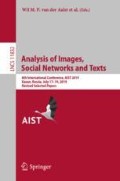Abstract
In this exploratory study, we analyze reading behavior using logs from an ebook reading app. The logs contain users’ page turns along with time stamps and page sizes in characters. We focus on 17 readers of War and Peace by Leo Tolstoy, who read at least 80% of the novel. We aim at learning a regression model for reading speed based on shallow textual (e.g. word and sentence lengths) and contextual (e.g. time of the day and position in the book) features. Contextual features outperform textual ones and allow to predict reading speed with moderate quality. We share insights about the results and outline directions for future research. The analysis of reading behavior can be beneficial for school education, reading promotion, book recommendation, as well as for traditional creative writing and interactive fiction design.
Access this chapter
Tax calculation will be finalised at checkout
Purchases are for personal use only
Notes
- 1.
- 2.
We were unable to test this hypothesis due to incomplete data.
- 3.
To calculate coverage we summed up all character ranges in the log entries for a particular reader. Coverage above 100% occurs, when the same text spans are read or just flipped through several times.
- 4.
- 5.
- 6.
References
Biedert, R., Hees, J., Dengel, A., Buscher, G.: A robust realtime reading-skimming classifier. In: Proceedings of the Symposium on Eye Tracking Research and Applications, pp. 123–130 (2012)
Bonch-Osmolovskaya, A., Skorinkin, D.: Text mining War and Peace: automatic extraction of character traits from literary pieces. Digit. Sch. Hum. 32(suppl\(\_\)1), i17–i24 (2016)
Braslavski, P., Likhosherstov, V., Petras, V., Gäde, M.: Large-scale log analysis of digital reading. Proc. Assoc. Inf. Sci. Technol. 53, 1–10 (2016)
Brouwer, A.-M., Hogervorst, M., Reuderink, B., van der Werf, Y., van Erp, J.: Physiological signals distinguish between reading emotional and non-emotional sections in a novel. Brain Comput. Interfaces 2(2–3), 76–89 (2015)
Chmykhova, E., Davydov, D., Lavrova, T.: Experimental study of factors of speed reading (Eksperimental’noe issledovanie faktorov skorosti chteniya). Russ. Psyhologiya Obucheniya 9, 26–36 (2014)
Constantinides, M., Dowell, J., Johnson, D., Malacria, S.: Exploring mobile news reading interactions for news app personalisation. In: Proceedings of the 17th International Conference on Human-Computer Interaction with Mobile Devices and Services, pp. 457–462 (2015)
DuBay, W.H.: The principles of readability (2004). http://www.impact-information.com/impactinfo/readability02.pdf
Kunze, K., et al.: Quantifying reading habits: counting how many words you read. In: Proceedings of the 2015 ACM International Joint Conference on Pervasive and Ubiquitous Computing, pp. 87–96 (2015)
Lagun, D., Lalmas, M.: Understanding user attention and engagement in online news reading. In: Proceedings of the Ninth ACM International Conference on Web Search and Data Mining, pp. 113–122 (2016)
László, J., Cupchik, G.C.: The role of affective processes in reading time and time experience during literary reception. Empir. Stud. Arts 13(1), 25–37 (1995)
Manguel, A.: A History of Reading. Knopf Canada, New York (1996)
Masson, M.E.J.: Cognitive processes in skimming stories. J. Exp. Psychol. Learn. Mem. Cogn. 8(5), 400–417 (1982)
Nell, V.: The psychology of reading for pleasure: needs and gratifications. Read. Res. Q. 23(1), 6–50 (1988)
Pitler, E., Nenkova, A.: Revisiting readability: a unified framework for predicting text quality. In: Proceedings of the Conference on Empirical Methods in Natural Language Processing, pp. 186–195 (2008)
Rayner, K.: Eye movements in reading and information processing: 20 years of research. Psychol. Bull. 124(3), 372 (1998)
Tibshirani, R.: Regression shrinkage and selection via the lasso. J. R. Stat. Soc. Ser. B (Methodol.) 58(1), 267–288 (1996)
Trauzettel-Klosinski, S., Dietz, K.: Standardized assessment of reading performance: the new international reading speed texts IReST. Investig. Ophthalmol. Vis. Sci. 53(9), 5452–5461 (2012)
Acknowledgements
We thank Bookmate for granting access to the dataset.
Author information
Authors and Affiliations
Corresponding author
Editor information
Editors and Affiliations
Rights and permissions
Copyright information
© 2019 Springer Nature Switzerland AG
About this paper
Cite this paper
Tukh, I., Braslavski, P., Buraya, K. (2019). Log-Based Reading Speed Prediction: A Case Study on War and Peace. In: van der Aalst, W., et al. Analysis of Images, Social Networks and Texts. AIST 2019. Lecture Notes in Computer Science(), vol 11832. Springer, Cham. https://doi.org/10.1007/978-3-030-37334-4_11
Download citation
DOI: https://doi.org/10.1007/978-3-030-37334-4_11
Published:
Publisher Name: Springer, Cham
Print ISBN: 978-3-030-37333-7
Online ISBN: 978-3-030-37334-4
eBook Packages: Computer ScienceComputer Science (R0)

